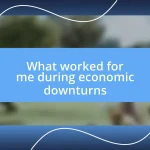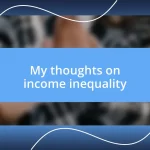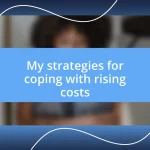Key takeaways:
- Discovering hip-hop’s roots in the Bronx and its evolution from community struggle to a global movement highlighted the genre’s significance in expressing identity and social issues.
- Engaging in community events, like cyphers and block parties, fostered a sense of unity and connection, showcasing how hip-hop serves as a powerful platform for storytelling and creativity.
- Learning from influential artists, such as Nas and Lauryn Hill, emphasized the importance of authenticity and vulnerability in hip-hop, inspiring personal growth and social commentary.

Discovering Hip-Hop Roots
As I delved into the world of hip-hop, I found myself drawn to its historical roots—tracing back to the vibrant streets of the Bronx in the 1970s. Imagine those block parties where DJs mixed beats, and MCs held audiences spellbound with their rhymes. Isn’t it remarkable how something born from struggle and community has evolved into a global movement?
One pivotal moment for me was discovering artists like Grandmaster Flash and Afrika Bambaataa. Their music felt like an invitation to explore social issues and cultural identity, which resonated deep within me. Have you ever felt a wave of connection when a song articulated the very feelings you couldn’t express? That’s what happened to me; it was as if these artists were speaking directly to my own experiences.
Learning about the four elements of hip-hop—MCing, DJing, graffiti, and breakdancing—opened my eyes to the richness of this culture. Each element is not just an art form but a lens through which to understand life, resistance, and creativity. I remember watching breakdancers spinning on cardboard, and it struck me how their movements conveyed a powerful story of resilience. Don’t you think that understanding these foundational aspects helps us appreciate the culture on a deeper level?

Understanding Hip-Hop History
As I continued my exploration of hip-hop history, I learned that it flourished as a response to socio-economic issues facing African American communities. The struggle to express identity and challenge the status quo resonated deeply with me. I remember a time when I was grappling with my own sense of belonging, and discovering how hip-hop provided a voice for those facing adversity helped me feel less alone.
Delving into key events, I was struck by the impact of early block parties and the role of local neighborhoods in shaping hip-hop culture. Participating in a community event in my area reminded me of those Bronx block parties—as I witnessed artists perform, it was clear how essential these gatherings are for fostering creativity and connection among individuals. Have you ever been part of something that felt like an unbreakable bond, just through music?
I can’t forget the powerful messages embedded in hip-hop lyrics. Listening to tracks from the likes of Tupac and Nas opened a window to emotional experiences that often mirror my own. The sheer passion behind their words stirs something in me—bringing forth a sense of urgency regarding social issues that persist today. Isn’t it inspiring to think how these artists not only entertained but also educated through their artistry?
| Key Events | Impact on Culture |
|---|---|
| Bronx Block Parties | Inspired community gatherings and birthed hip-hop |
| Formation of Hip-Hop Collectives | Built a platform for collaboration and creativity |

Exploring Key Hip-Hop Elements
Exploring the various elements of hip-hop was like opening a treasure chest filled with cultural richness. I still vividly remember the first time I picked up a spray can and tried my hand at graffiti. The rush of expressing myself visually felt transformative; it turned a blank wall into my canvas, conveying messages that words sometimes failed to capture. Doesn’t it feel liberating to create something that speaks to your essence?
Here are the four foundational elements of hip-hop that embody this dynamic culture:
- MCing (Rapping): The art of rhythm and wordplay, where storytelling intertwines with beats.
- DJing: The backbone of hip-hop, where DJs blend sounds and craft seamless musical experiences.
- Graffiti: Visual art that serves as a form of protest and self-expression, turning urban spaces into galleries.
- Breakdancing: A physical manifestation of emotion, creativity, and resilience, reflecting the dancer’s individuality.
Each element intertwines, creating an intricate tapestry that defines hip-hop. I recall attending a local MC battle where the energy in the room was palpable. Watching artists battle it out with sharp wit and quick delivery made me appreciate the intellect involved in MCing. It’s not just about rhythm; it’s also about how each verse pushes the boundaries of creativity. Can you feel that excitement when words come alive like that?
When I discovered how these elements contribute to a collective identity, it fueled my own connection to hip-hop. They are not mere techniques; they are the voices of generations and the heartbeat of communities, offering stories that touch on struggle, hope, and perseverance. Each time I see a dance crew perform or hear a DJ mix, I’m reminded that hip-hop isn’t just a genre; it’s a powerful movement that resonates with anyone willing to listen and connect.

Engaging with Community Events
Engaging with community events has been one of the most rewarding experiences on my hip-hop journey. I vividly recall my first visit to a local cypher, where individuals gathered to share their verses under the glow of a streetlamp. The sense of camaraderie was palpable; everyone encouraged one another, creating an atmosphere that felt both electric and welcoming. Have you ever felt so connected to strangers through a shared passion? That moment made me realize how hip-hop can bridge gaps and cultivate community.
I can’t help but think about how community events are not just about the music; they embody the spirit of unity and resilience. I remember attending a neighborhood cookout that featured live performances by local artists. Watching their expressions as they poured their hearts into every line was incredibly moving. It struck me how these gatherings create spaces where voices can be amplified, and stories can be told—stories of struggle, hope, and triumph. Isn’t it something special to see art come alive in such a relatable setting?
Being involved in these events has shown me the importance of supporting local talent and artists. Each graffiti mural I see at a community event tells a story, while a breakdancer’s moves narrate a history of perseverance. I once participated in a workshop that brought together aspiring MCs and dancers, and it felt like magic. The creativity flowing from shared experiences and collaboration transformed us all. It left me wondering how many more hidden gems are waiting to be uncovered in our neighborhoods. Do you ever think about the untapped potential right around the corner?

Learning from Influential Artists
Learning from influential artists has profoundly shaped my appreciation for hip-hop. I remember the first time I listened to Nas’s “Illmatic.” The layers of storytelling and intricate wordplay transported me to his world, making me feel the struggles of life in the projects. Have you ever felt that connection with a song? It illuminated for me how music could serve as a powerful lens through which to view different experiences.
Being inspired by artists like Lauryn Hill offered me a deeper understanding of vulnerability in hip-hop. Her raw emotion in “Doo Wop (That Thing)” resonated with me, awakening a sense of self-reflection. I found myself questioning how I convey my own experiences through art. What messages do I want to share? This kind of introspection taught me that every verse is a chance to communicate not just skill, but also authenticity.
It’s incredible how influential figures like Kendrick Lamar challenge societal norms through their music. I recall attending a talk where we analyzed the themes in “To Pimp a Butterfly.” The conversation opened my eyes to hip-hop as a vehicle for social commentary. Every bar is a statement, every beat a call to action. Doesn’t that inspire you to think about how your own creations might spark change? Learning from these artists has truly transformed both my understanding and my engagement with the culture.

Creating Personal Connections
Creating personal connections within the hip-hop culture has been a journey of discovery for me. I vividly remember the first time I stumbled upon a local open mic night. As I watched performers step onto the stage, I felt a rush of excitement. They didn’t just share their music; they bared their souls. It made me realize how powerful it is to express oneself in front of others. Do you recall a moment when someone’s story moved you deeply?
Sometimes, it’s the simple interactions that leave a lasting impact. I once shared a conversation with a tattoo artist at a hip-hop festival who used his art to tell stories from his life. Listening to him reflect on how each tattoo represented a chapter of his journey felt like an intimate glimpse into his world. I found myself connecting over shared experiences—the trials and triumphs we all face in life. Was it coincidence, or was it the magnetic pull of the culture that brought us together?
As I engaged more deeply, I discovered the importance of mentorship within hip-hop. I attended a workshop led by a seasoned rapper who emphasized the significance of passing on knowledge and skills. The energy in the room was palpable as emerging artists shared their hunger to learn. It dawned on me that every connection made has the potential to uplift someone else. Have you considered how your experiences could inspire someone on their journey? Each story shared is a thread woven into the rich tapestry of hip-hop, reinforcing community and creativity.

Sharing My Hip-Hop Journey
Sharing My Hip-Hop Journey
My hip-hop journey intensified when I met a group of breakers during a community festival. The way they moved, each spin and freeze, felt like a narrative unfolding through their bodies. I can’t help but wonder—what stories are they telling with each step? Watching them ignited a fire in me to connect deeper with the art forms surrounding hip-hop.
I also recall the electrifying energy of a cypher I participated in one cool summer night. As I waited for my turn, I felt a mix of anxiety and anticipation. When I finally stepped into the circle, it was as if time stood still; the moment transformed me. I poured my heart out, sharing not just rhymes but pieces of my life. I could see nods of understanding from others, and it made me think—how does vulnerability create bonds in this culture?
One of my most memorable experiences was collaborating on a track with a talented friend. The process taught me that hip-hop isn’t just about individual expression; it’s about collaboration. We experimented with beats and flowed through narratives that felt raw and real. Have you ever felt that spark when ideas collide? It truly emphasized how the culture thrives on collective creativity, leading me to appreciate our diverse voices even more.














